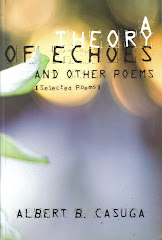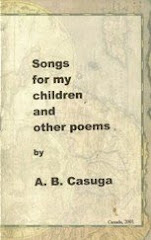A GIFT OUTRIGHT
It was a triple treat. Yesterday, we had dinner at the Kwan’s. (Alvin and April and their two smart daughters, Taylor and Sydney). Taylor surprised me with a chapbook of her poems. Sydney sang me a Latin song, and she challenged us to an ultra-competitive game on the Wii (bowling and tennis).
My son-in-law, Alvin, grills the best sirloin and rib-eye steaks this side of town. April, a daughter who works as a manager at Bell, marinates simply the tastiest steaks this side of Canada.
And my two elementary-school granddaughters? Taylor said she had a surprise for me as soon as she gave us (her grandparents and an aunt) the customary kisses. She calmed down a tad when she finally gifted me with her surprise, a collection of her poems, “Young Poems.”
(This is a déjà vu, if there were one. Much earlier, in high school, my only son, Albert Beau, gave me his collection of poems---posted in this blog two years ago---a 9 x 5 side-stitched work! Down memory lane, there was the collection of poems by eldest grandchild, Diana Dy, [now 21, and living on her own] when she was in grade eight.)
I would not be able to share the sumptuous dinner, nor let you listen to that angelic Latin hymn (Sydney did not understand the verbum domine but she heroically phrased them correctly, and even showed grandpa a copy of the piano piece so I could make out some of her Anglicised pronunciation of the ancient language. I have good reason now to thank my university Latin classes!
But I could regale you with some of Taylor’s poems. I thank her with all the gladness and pride of a grandfather and, I might hazard, an uber mentor (she would not cede the primacy of Miss Sordo, her St. Valentine’s teacher in grade seven, who is now teaching them haikus, cinquain, “list” poems, concrete poems, limericks, and all those forms calculated to make them like if not love poetry).
One time or the other, she asked my assistance in doing her poetry-writing homework. She included the following haiku “Sea Waters” as a work in collaboration with grandpa, on page 4 of her 10-poem collection.
(Some teachers at that school recognise my being an author of poetry books, thanks to the show-and-tell efforts of Sydney who has brought some of my work to school to show proof that grandpa is indeed a poet, some three books so far for the same number of times now.)
Sea Waters
Watch the river flow
Turning blue when it’s near sea
Waters, like a child.
Without offering an involved analysis (oh, don’t becloud the many-splendoured thing), let me assure you that the haiku follows the 5-7-5 syllable-three-line classical structure. But does it make a poetic point? Take a look at that third line.
Her collection includes a “biography poem”, entitled Kwan, four haikus, a “list” poem, a limerick, a traditional cinquain, a modern cinquain, a “letter-perfect poem (each line starting with word starting with T), a poem using couplets, and a concrete poem she called “diamond poem” (see image below).
The ice under the snow
Glitter with sunshine glow
It is a pity there will be thaw
Sooner rather than later, nature’s law
It will melt away with April showers
Preparing for the buds of May flowers
The sun will make puddles disappear
The warmth of the air...summer is near
The sequence of the seasons is clear and so are the images that are normally associated with them. Her teacher, obviously, should teach her how poems are punctuated, because they also share that with prose.
Here’s a cinquain with its traditional 2-4-6-8-2 syllable-counted strophe:
The Sun
The sun
Golden yellow
Brings you up when you’re down
Shines down on you like a spotlight
Glowing.
Having learned how other media could help in “hardening” images in poetry, she also uses colours as in the following collection of haikus in a single page. (See image. Click on the image to zoom on the text.)
You can’t beat a triple treat in a day, can you?
---Albert B. Casuga
06-05-11














No comments:
Post a Comment